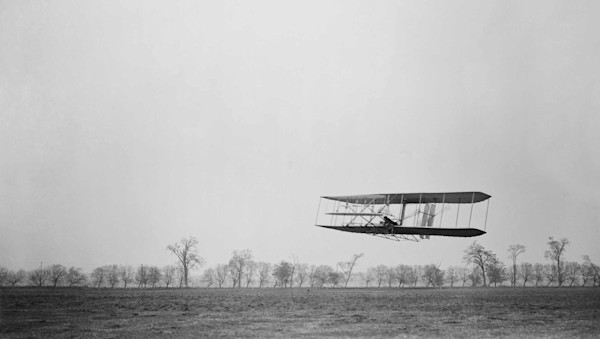The First Aviation Mechanic: Charles E. Taylor

December 17th, 1903 is an extremely important day in the history of aviation. On that day over 100 years ago, the first successful flight took place, piloted by brothers Wilbur and Orville Wright. However, what many may not know is the mastermind behind the success was Charles E. Taylor -- the very first aviation mechanic. While the Wright brothers are frequently give all the credit for the flight, many leave out Taylor and his crucial contributions to their accomplishments. The milestone flight in Kitty Hawk, North Carolina could not have been triumphant without Charles E. Taylor, "the man aviation history almost forgot".
Early Childhood & Adulthood
Charles Edward Taylor was born May 24, 1868 in the rural Illinois town of Cerro Gordo. A few years later, his family relocated to Nebraska. While most of his early childhood remains undocumented for, Taylor worked as an errand boy for the Nebraska State Journal in his early teen years. Working at the Journal proved to be very profound for Taylor as he discovered his talent for mechanics while working in their bindery. In his early 20s, Charles moved to Kearney, Nebraska where he started his own business of making metal house numbers allowing him to refine his mechanical skills that he had no idea would come to such great use later in his life. In 1984, he married a woman named Henrietta Webbert. Henrietta and her family was originally from Dayton, Ohio, and her family was acquainted with Bishop Milton Wright, father of Wilbur and Orville. Only a few short years later, Charles Taylor would be introduced to the Wright Brothers.
Early Career
Early in their marriage, the Taylors relocated to Dayton, Ohio to be closer to Henrietta's family. Additionally, Dayton was plentiful with prospective jobs for Charles where he could utilize his mechanically inclined talent. Charles soon began working for Stoddard Manufacturing Co. to make farm machinery and bicycles. Taylor then left Stoddard and opened up his own tool shop where he did general repair work on gas stoves and bicycles -- and his relationship to the Wright brothers was born. He began to work closer and closer with them, until eventually they offered him a job at their bicycle business. On June 15, 1901, Taylor began working at the Wright Cycling Company making $18 a week.
Charles' main job at the Wright Cycling Company was to assist customers and manage the shop when the brothers weren't there while occasionally doing some bicycle repair work. Taylor was aware of the experiments Wilbur and Orville were frequently off doing in North Carolina, but he was never involved in any of them. When the brothers needed help building a wind tunnel for their gliders, Taylor was asked to assist. This would be his very first introduction to helping the Wright brothers with their aviation endeavors. After this experiment was successful in 1902, the Wilbur and Orville returned home from Kitty Hawk and they realized their next big hurdle - to build an engine.
Aviation Success
After realizing their need for an engine, the Wright brothers looked for a manufacturer who could construct an engine capable of producing the outcome they were hopeful for. However, after decline after decline from many gasoline engine manufacturers, they turned to Charles Taylor. While Taylor had limited experience building engines, he still agreed to attempt to build a lightweight, low vibration eight-horsepower engine. The Wright brothers provided rough sketches to Taylor, and only six weeks later, the first aviation engine was ready for flight. Charles produced the first ever aviation engine - a twelve-horsepower engine made from cast aluminum block and crankcase weighing 152 pounds. This invention would later deem him the first ever aviation mechanic.
Unable to go with the brothers to test flight the new aircraft, Charles stayed back to "mind the store". On the 17th of December in 1903, Wilbur and Orville Wright had four successful flights in Kitty Hawk, North Carolina, all due to Charles Taylors engine.
Conclusion
After their success in Kitty Hawk, the Wright brothers and Taylor continued to make aviation history. The trio continued to make and improve different engines and flyers, and the Wright brothers eventually became household names. The brothers and Taylor slowly drifted apart as their accomplishments catapulted them to fame, and Charles moved to California to try and improve his wife's health. As Taylor's health declined, he was admitted to the Los Angeles Hospital's charity ward.
Charles Edward Taylor died on January 30th, 1956. He was buried in Valhalla Memorial Park, Los Angeles at the Portal of Folded Wings Mausoleum, a shrine dedicated to aviation pioneers. Today, although Charles Taylor may not get the amount of recognition he deserves, his breakthrough that allowed aviation mechanics to be where they are today is not forgotten. His birthday, May 24th, is recognized as Aviation Maintenance Technician Day. Additionally, the Charles Taylor Master Mechanic award is given by the Federal Aviation Administration to honor lifetime achievements from senior aviation mechanics.
References:
https://www.nps.gov/people/charles-e-taylor.htm
https://www.faa.gov/about/history/pioneers/media/charles_e_taylor.pdf
https://airandspace.si.edu/support/wall-of-honor/charles-e-taylor
https://www.nps.gov/people/charles-e-taylor.htm
